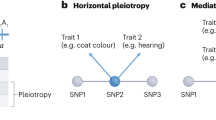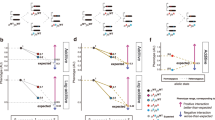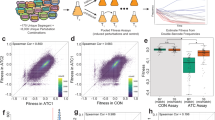Abstract
Non-additive genetic interactions contribute to many genetic disorders, but they are extremely difficult to predict. Here we show that genetic interactions identified in yeast, unlike gene functions or protein interactions, are not highly conserved in animals. Genetic interactions are therefore unlikely to represent simple redundancy between genes or pathways, and genetic interactions from yeast do not directly predict genetic interactions in higher eukaryotes, including humans.
This is a preview of subscription content, access via your institution
Access options
Subscribe to this journal
Receive 12 print issues and online access
We are sorry, but there is no personal subscription option available for your country.
Buy this article
- Purchase on SpringerLink
- Instant access to full article PDF
Prices may be subject to local taxes which are calculated during checkout

Similar content being viewed by others
References
Giaever, G. et al. Nature 418, 387–391 (2002).
Kamath, R.S. et al. Nature 421, 231–237 (2003).
Davierwala, A.P. et al. Nat. Genet. 37, 1147–1152 (2005).
Pan, X. et al. Cell 124, 1069–1081 (2006).
Tong, A.H. et al. Science 303, 808–813 (2004).
Tischler, J., Lehner, B., Chen, N. & Fraser, A.G. Genome Biol. 7, R69 (2006).
Lehner, B., Crombie, C., Tischler, J., Fortunato, A. & Fraser, A.G. Nat. Genet. 38, 896–903 (2006).
Matthews, L.R. et al. Genome Res. 11, 2120–2126 (2001).
Byrne, A.B. et al. J. Biol. 6, 8 (2007).
Hartman, J.L. Science 291, 1001–1004 (2001).
Hughes, T.R. et al. Cell 102, 109–126 (2000).
Acknowledgements
The C. elegans strains used in this work were provided by the C. elegans Genetics Center, USA, and by the National Bioresources Project, Japan. We thank J. Taipale, D. Stemple, M. Isalan, J. Semple and T. Vavouri for comments on the manuscript. We also thank the referees for their comments. J.T. and A.G.F. were funded by the Wellcome Trust. B.L. was supported by the Wellcome Trust, Institutió Catalana de Recerca i Estudis Avançats, and the European Molecular Biology Laboratory-Centre for Genomic Regulation Systems Biology Unit.
Author information
Authors and Affiliations
Corresponding author
Supplementary information
Supplementary Text and Figures
Supplementary Methods, Supplementary Figures 1–3, Supplementary Tables 3, 5 and 6 (PDF 324 kb)
Supplementary table 1
C. elegans orthologs of S. cerevisiae synthetic lethal interactions. (XLS 726 kb)
Supplementary table 2
S. cerevisiae synthetic lethal interactions and their pairwise C. elegans orthologs. (XLS 149 kb)
Supplementary table 4
C. elegans orthologs of S. cerevisiae synthetic lethal interactions with homozygous viable loss-of-function alleles. (XLS 69 kb)
Rights and permissions
About this article
Cite this article
Tischler, J., Lehner, B. & Fraser, A. Evolutionary plasticity of genetic interaction networks. Nat Genet 40, 390–391 (2008). https://doi.org/10.1038/ng.114
Received:
Accepted:
Published:
Issue Date:
DOI: https://doi.org/10.1038/ng.114
This article is cited by
-
High-content behavioral profiling reveals neuronal genetic network modulating Drosophila larval locomotor program
BMC Genetics (2017)
-
New _targeted Agents in Gynecologic Cancers: Synthetic Lethality, Homologous Recombination Deficiency, and PARP Inhibitors
Current Treatment Options in Oncology (2016)
-
A high-resolution gene expression atlas of epistasis between gene-specific transcription factors exposes potential mechanisms for genetic interactions
BMC Biology (2015)
-
Long-term phenotypic evolution of bacteria
Nature (2015)
-
TOPS: a versatile software tool for statistical analysis and visualization of combinatorial gene-gene and gene-drug interaction screens
BMC Bioinformatics (2014)



